Growing A Dipladenia Plant - Learn The Difference Between Dipladenia And Mandevilla


Tropical plants have a special place in my heart. My gardening zone is not at all sultry, warm and humid, but it doesn't stop me from purchasing a bougainvillea or other tropical plant for outdoor use. The plants thrive in summer but have to be moved indoors in the cooler season. Dipladenia, a favorite, is a South American native that grows in tropical forests.
The plant is similar to mandevilla vine and works outside in warm zones, or indoors as an accent houseplant. We will discuss the difference between dipladenia and mandevilla so you can decide which of these amazing flowering vines is the best option for your garden.
Mandevilla or Dipladenia
Dipladenia is in the Mandevilla family but has a decidedly different growth pattern. Mandevilla vines climb up vertical structures to seek the canopy light. Dipladenia is a bushier plant whose stems grow down and hang.
The two plants have similar brightly colored flowers, but mandevilla has a larger flower typically in red. Both plants need the same bright light and dipladenia care is the same as that for the mandevilla vine. When deciding between a mandevilla or dipladenia, the finer leaves and smaller flowers in a wide range of colors may win the day for the dipladenia.
Dipladenia Facts
Dipladenia has a fuller shape than the mandevilla. A major difference between dipladenia and mandevilla is the foliage. Dipladenia leaves are fine and pointed, deeply green and slightly glossy. Mandevilla vine has larger leaves with a broader shape. The flowers are trumpet shaped and full in hues of pink, white, yellow and red.
The plants respond well to pinching as they grow, which forces out new bushier growth. Unlike the mandevilla, dipladenia doesn't send out as much upward growth and doesn't need staking. One of the better dipladenia facts is its ability to attract hummingbirds and bees. The tubular flowers are a vibrant signal to pollinators as ample suppliers of nectar.
Growing a Dipladenia Plant
This plant requires warm temperatures for best performance. Nighttime temperatures should remain around 65 to 70 F. (18-21 C). Water the plant frequently in the summer but let the top few inches of the soil dry out before watering anew.
Gardening tips, videos, info and more delivered right to your inbox!
Sign up for the Gardening Know How newsletter today and receive a free download of our most popular eBook "How to Grow Delicious Tomatoes."
The plant can go in the ground in warmer areas or stay in a pot. Bright but indirect sun is a requirement for growing a dipladenia plant. The best flowers are formed in a well lit area. Pinch off gangly growth when the plant is young to force thicker stronger branches.
The only difference between mandevilla and dipladenia care is that mandevillas require a trellis or staking. Dipladenia only needs a stake to keep the little plant straight as it matures. Fertilize every three to four weeks during the growing season with a liquid plant food as part of good dipladenia care.
Overwinter indoors or in a greenhouse and suspend fertilizing in winter. With a little luck, even northern gardeners can keep the plant growing indoors until the heat of summer arrives.

Bonnie Grant is a professional landscaper with a Certification in Urban Gardening. She has been gardening and writing for 15 years. A former professional chef, she has a passion for edible landscaping.
-
 How To Grow Garden To Table: A Guide For Home Cooks
How To Grow Garden To Table: A Guide For Home CooksWhat could be better than a meal that comes directly from garden to table? Show off your gardening and culinary skills with the very freshest food.
By Bonnie L. Grant
-
 Want a Backyard Mini Orchard? Create Your Own Container Orchard
Want a Backyard Mini Orchard? Create Your Own Container OrchardEasier to care for in small spaces, a backyard mini-orchard makes sense for busy gardeners and juicy fruit is the reward.
By Teo Spengler
-
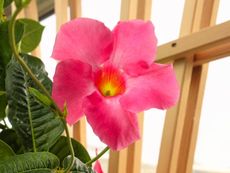 How Much Light Does A Mandevilla Need Indoors?
How Much Light Does A Mandevilla Need Indoors?You can overwinter a beautiful mandevilla indoors, but it has special lighting needs. Read on to learn more about it.
By Amy Grant
-
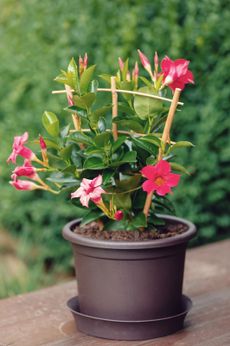 Repotting Mandevilla Plants: Learn How To Repot Mandevilla Flowers
Repotting Mandevilla Plants: Learn How To Repot Mandevilla FlowersMandevilla is a reliable flowering vine with stunning, trumpet-shaped blooms. In cooler climates, it is grown as an indoor plant. Occasional repotting is necessary to keep the plant healthy and repotting mandevilla isn’t difficult. This article will help.
By Mary H. Dyer
-
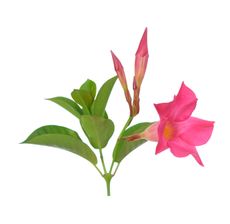 Dipladenia Cutting Propagation – How To Root Dipladenia Cuttings
Dipladenia Cutting Propagation – How To Root Dipladenia CuttingsDipladenia is a tropical vining plant similar to Mandevilla. Many gardeners grow these vines from cuttings to grace a garden bed or patio. Perhaps, you are interested in growing this lovely vine for yourself. For tips on how to root Dipladenia cuttings, click this article.
By Teo Spengler
-
 Mandevilla Plant Tubers: Propagating Mandevilla From Tubers
Mandevilla Plant Tubers: Propagating Mandevilla From TubersThere are several easy ways to start a new mandevilla plant, including seeds and softwood cuttings, but propagating mandevilla from tubers probably isn?t a viable method of propagation. Click here to learn more about mandevilla plant tubers.
By Mary H. Dyer
-
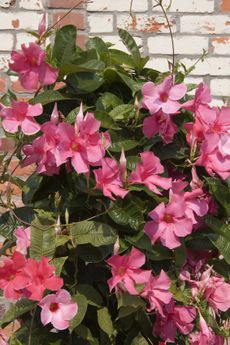 Should I Cut Back Mandevilla – When To Prune Mandevilla Vines
Should I Cut Back Mandevilla – When To Prune Mandevilla VinesIf allowed to grow untended, mandevilla can start to get an unkempt appearance and not flower as much. This is why pruning mandevilla vines at least once per year is recommended. Learn more about how to cut back a mandevilla in this article.
By Liz Baessler
-
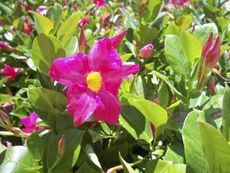 Mandevilla Ground Cover – How To Use Mandevilla Vines For Ground Covers
Mandevilla Ground Cover – How To Use Mandevilla Vines For Ground CoversA mandevilla vine can scramble over a slope as fast as it can climb a trellis, especially in areas where it is difficult to plant grass. Read this article for information about using mandevilla vines for ground covers.
By Teo Spengler
-
 Mandevilla Blooming Season: How Long Do Mandevillas Flower
Mandevilla Blooming Season: How Long Do Mandevillas FlowerWhen does mandevilla vine bloom? How long do mandevillas flower? All good questions, and the answers depend on a number of factors. Read this article for specific information about the mandevilla blooming season. Click here to learn more.
By Mary H. Dyer
-
 Winterizing Mandevillas: Tips For Overwintering A Mandevilla Vine
Winterizing Mandevillas: Tips For Overwintering A Mandevilla VineIf you live in a more northern climate, planting mandevilla in a container is the best way to go. Click this article for tips on winterizing mandevillas.
By Mary H. Dyer